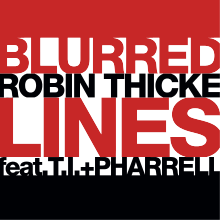 |
| Sinal Govender |
Blurred lines unblurring the issue of copyright infringement...
"The
chart topping song "Blurred Lines" by Robin Thicke feat. Pharrell
Williams has been engulfed in a hurricane of controversy since it first hit the
airwaves in 2013. While the lyrics of the song have received most of the
criticism, many
music loving folk couldn't help but notice the marked resemblance to
Marvin Gaye's 1977 hit "Got to Give It Up".
An
LA jury has now put the issue to bed, for now, in a verdict that has ordered
Thicke and Williams to collectively pay a whopping 7.4 million dollars to
Gaye's family for infringing the copyright in Gaye's song, more specifically the copyright in the sheet music of the
song. It remains to be seen whether or not the decision will go on
appeal, as Thicke and Williams seem to maintain that their song was created independently.
Watch this space.
 This
decision comes hot on the heels of an allegation earlier this year that Sam Smith's grammy winning
"Stay with Me" copied aspects from Tom Petty's "I Won’t Back Down".
Although Smith claimed that the similarity was a complete musical coincidence, Petty and co-writer Jeff Lynne
were subsequently given partial credit for Smith's song in a settlement agreement that escaped the courts, but
not the media.
This
decision comes hot on the heels of an allegation earlier this year that Sam Smith's grammy winning
"Stay with Me" copied aspects from Tom Petty's "I Won’t Back Down".
Although Smith claimed that the similarity was a complete musical coincidence, Petty and co-writer Jeff Lynne
were subsequently given partial credit for Smith's song in a settlement agreement that escaped the courts, but
not the media.
So
what does this mean in a South African context? One of the other Leos
previously reported on something similar when Gavin Rajah was accused of
copying a design by Zunaid Murad last year (read her take on it here). Indeed, these accusations appear to follow Rajah who just this week has also borne the brunt of similar criticism.
Essentially, our courts have held that
copyright infringement involves a two stage inquiry: not only must there be an
objective measure of similarity between the works, but a causal connection between
the two needs to be established as well.
In
everyday speak, two works, even strikingly similar, could still enjoy copyright
protection without necessarily infringing on the other. What sets Smith
apart from Thicke and Williams may be that Smith claimed never to have heard of
Petty's song before creating his own, and this was never questioned.
(Although it's easier not to question things while being comforted by the
royalties that resulted from the agreement). On the other hand, while Thicke and
Williams claim to have created their work independently, evidence emerged
during their trial that saw both of them admitting to drawing inspiration from
Gaye. Sinking nails into his proverbial coffin, Thicke was even quoted as
admitting that Gaye's song was one of his favourites and that he and Williams "should write a song with the
same groove".
Naturally,
the more two works have in common, the less likely a court, or anyone else, is
going to believe that they were created completely independently of each other.
An exception to this may be the age old example of photographers taking photos
of iconic locations, which are available to all, such
as THE mountain in the fair Cape.
Copyright
is a fundamental tool to any creative mind, especially those in the fashion and
entertainment industries: it does not require any formal registration before it
can be enforced, and it can therefore be a vital tool in protecting your IP if
you know how to handle it correctly. A
simple, but effective, piece of advice is to keep as clear of a record of your
creative process as possible and to obtain permission
from anyone inspiring that process, if at all in doubt.
This
writer is grateful not to be in a position to ultimately decide on whether any
foul play has taken place in the contexts set out above. Musos will
always have muses, but they should be careful
not to tread on any copyright protected toes. After
all, there are certainly better things on which to spend 7.4 million
dollars."
Incidentally, the fine line between illegal copying and inspirational works will be the basis for discussion tonight on CNBCAfrica at 18h30 where this Afro Leo will be joining a panel including Kyle Boshoff of African Fashion International.
If you would like to submit a guest post to Afro-IP or be considered as a guest blogger, please contact us here.









1 comments:
Write commentsThe American copyright seems so complicated, it is a web that seems to 'blur' the idea/expression dichotomy more often. South Africa on the other hand seems to be producing sound jurisprudence on copyright issues.
Reply